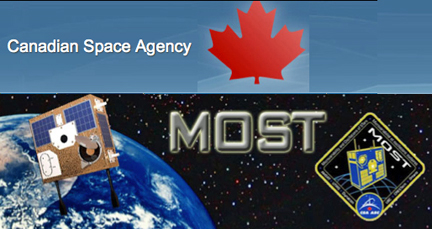
[SatNews] After more than ten years of studying the Universe, the Canadian Microvariability and Oscillation of STars (MOST) mission will come to an end on September 9th, 2014, having exceeded its objectives.
Since its launch in 2003, MOST has produced more than 100 science publications and provided astronomers with new insights into the behavior of stars. Originally planned as a one-year project, MOST was extended annually due to the telescope’s continued successes.The suitcase-sized telescope will leave a prolific legacy of data for astronomers to analyze.
In the fall of 2013, the Canadian Space Agency (CSA) conducted a mission extension review in cooperation with members of Canada’s astronomy community. The evaluation weighed the mission’s ongoing operational costs against its objectives and new alternatives to obtain similar data. The review led to the recommendation that the mission be terminated, considering that MOST had already surpassed its objectives. MOST has helped a new generation of astronomers and space engineers advance their studies and research. Under the leadership of its Principal Investigator, Dr Jaymie Matthews of the University of British Columbia, the MOST science team currently includes members from: the University of British Columbia, the University of Toronto, Université de Montréal, St-Mary’s University, the University of Vienna, Harvard University and NASA’s Ames Research Center.
- The space telescope will complete its current list of planned observation targets by September 9, 2014.
- The CSA is working with the University of British Columbia, the National Research Council Canada, and the Université de Montréal to archive MOST’s data at the Canadian Astronomy Data Center, thus making the mission’s data available to the world’s astronomy community for future use.
- One of MOST’s keys findings includes the surprising discovery that the star Procyon, the eighth brightest in the night sky, does not oscillate or vibrate—in astronomical terms, it has no pulse—challenging researchers’ understanding of the life cycle of stars.
- In 2011, MOST confirmed the existence of a suspected—and rather odd— exo-planet around the star 55 Cancri. This planet, called 55 Cancri, is very close to the star, orbiting it in only 17 hours. The planet is about eight times denser than Earth, making it one of the densest exo-planets known
- Under the “My Own Space Telescope” public contest, the MOST mission offered amateur astronomers opportunities to observe targets of their choice. Canadian stargazers selected the red supergiant star Betelgeuse in the constellation of Orion and looked at matter around a quasar, which is a star-like object from outside our galaxy that emits large amounts of energy
- The prime contractor for MOST’s satellite and ground station operations is Mississauga-based Microsat Systems Canada Inc. (MSCI).
- Key stakeholders and partners included: the University of British Columbia, the University of Toronto Institute for Aerospace Studies’ Space Flight Laboratory, as well as the Centre for Research in Earth and Space Technology (CRESTech) of Toronto, the Radio Amateur Satellite Corporation (AMSAT), which includes both Canadian and U.S. chapters, AeroAstro, Inc. of Ashburn, Virginia, Spectral Applied Research, Routes AstroEngineering, the Royal Astronomical Society of Canada (RASC), and Sumus Technologies
“Thanks to the Canadian Microvariability and Oscillation of STars telescope, Canadian astronomers have produced a decade’s worth of astounding discoveries and Canada’s space industry gained essential expertise. As MOST prepares for its retirement, I offer my congratulations to the talented team of astronomers and engineers on this Canadian science and technology success story.”—General (Retired) Walter Natynczyk, CSA President

